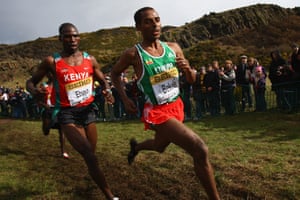I have never forgotten watching Kenenisa Bekele in the 2008 World Cross Country Championships in Edinburgh: on the final lap of the muddy course, where it throws in a nasty hill, he seemed to accelerate away effortlessly, leaving a world-class field behind him. I could not begin to comprehend how he had done it (testament to his excellent form, as well as astounding ability). A track runner through my teens, I liked to see the finish line from the start and to enjoy the lower gravitational pull of a zero gradient. I’m not saying I wasn’t prepared to feel some pain: just that I preferred it to be short and sharp.
Fast-forward a few years and I found myself living in a beautiful, mountainous region, where large sections of the populace hiked, biked and ran. Every other car had a bike rack and a patchwork of bumper stickers with slogans such as: “Train with altitude”. In essence, here was a place where hills were embraced, and if you wanted to run, then you had to run uphill. There was nowhere else to go. So over the following three years I developed a profound love of doing just that.
As my running progressed, so did my obsession with conquering the climbs – this was not, for me, about being the fastest to the top, but about learning to be as efficient as possible, and able to approach that section of a route without instinctively imploding. During my own uphill efforts, I would constantly ponder how much of my ability to keep going (or not) was in my head. Always keen to learn from others, I used the local track club to contact a number of runners in the area, from recreational to elite, and ask them about their own approaches: “What do you think about when you’re running up a hill,” I asked.

Responses to my simple question ran from “Oh my God, it’s a hill!”, through “I wonder how soon I’ll have to walk”, to “I must go faster!” (needless to say, the last was from one of the elites). So how can a person go from feeling defeated before the start, to being in a position to attack? And how much of it is about mental attitude? The answer is, of course, that we are all different and – as for any form of endurance sport – the mind plays more of a part for some than others. Some athletes have mantras that they repeat to themselves; some use visualisation techniques; others think about anything except the hill itself.
My own tactic is to try to focus on my form, downshift to shorter strides, think about knee lift and keep loose and relaxed. Legendary ultramarathoner Scott Jurek compares it with changing down the gears on a bike as the gradient increases and I like that analogy: it helps to maintain an even cadence as you transition from flat to hill. In his book, Eat and Run, he writes “In cycling, the smart (and fast) racer shifts into an easier gear when he hits the incline but maintains his pedal revolutions per minute… I found that by shortening my stride, I could ‘spin’, maintaining the ideal turnover of 180 foot strikes per minute. Downhill, I lengthened my stride but stayed light on my feet, and kept the same 180 footfalls-a-minute pace.”
Certainly you can’t beat physical training: getting out there and running uphill will make you better at running up hills. Leg and core-strength exercises, from squats to leg presses – or riding a bike – all have a significant effect on your ability to climb efficiently, and this in turn influences your mental attitude. If you feel physically stronger, then your confidence will naturally be enhanced and the hills will appear less daunting. There are plenty of online resources for those seeking training tips (Brian Mac is an excellent example). And, of course, hill training will also increase a runner’s strength, lactic tolerance and speed over any terrain, so what is there not to love?
Finally, once you’ve conquered the ascent and surveyed the view from the top, gravity becomes your friend (not just the law) and you can let loose on the run down. As well as initiating a nice injection of adrenaline and allowing you to feel like you have wings on your feet, there is also evidence that running downhill as part of your schedule will not only improve your balance and coordination, but help to make you a faster runner overall. So come on people, start celebrating those hills! The only way is up.
Source: Read Full Article
